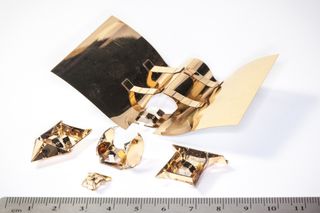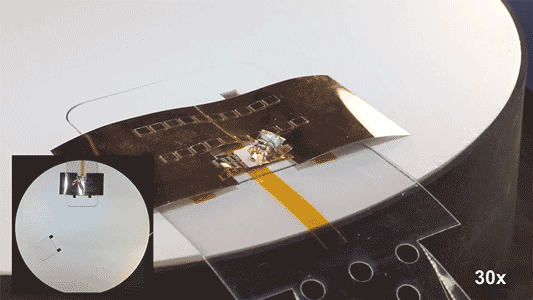Origami-Style Suits Turn Robots into Real-Life 'Transformers'

Just as one might don a wet suit to work underwater or a spacesuit to work in space, researchers are designing exoskeletons for robots so the machines can wear a variety of outfits tailored to different missions.
In experiments, self-folding, heat-activated origami suits created for robots could help the machines walk, roll, sail and glide, according to the new study.
"Imagine future applications for space exploration, where you could send a single robot with a stack of exoskeletons to Mars," study co-author Shuguang Li, a postdoctoral fellow at MIT's Computer Science and Artificial Intelligence Laboratory, said in a statement"The robot could then perform different tasks by wearing different outfits." [Super-Intelligent Machines: 7 Robotic Futures]
Unlike the shape-shifting robots in the "Transformers" films, in real life, existing bots are typically much less adaptable. Each part of a robot usually has a fixed structure and a single, defined purpose, making it difficult for robots to perform a wide variety of actions, the researchers said.
In contrast, animals can often change their shapes to adapt to their environments. For instance, caterpillars undergo metamorphosis to become butterflies, and hermit crabs can switch their shells.
The scientists drew inspiration from nature to develop a robot that could transform itself with different outfits that enable it to perform different tasks.
"If we want robots to help us do things, it's not very efficient to have a different one for each task," study senior author Daniela Rus, director of MIT's Computer Science and Artificial Intelligence Laboratory, said in a statement. "With this metamorphosis-inspired approach, we can extend the capabilities of a single robot by giving it different accessories to use in different situations."
Sign up for the Live Science daily newsletter now
Get the world’s most fascinating discoveries delivered straight to your inbox.

The researchers used a small magnetic cube that they called "Primer." They placed the cube in an arena where they could use magnetic fields to make Primer move like a robot.
In experiments, the scientists had Primer move onto various plastic origami sheets mounted on hot plates. Turning on the hot plates could then make the heat-activated sheets fold around the cube into various shapes in roughly 3 minutes.
Each of the exoskeletons Primer could wear had its own advantages. For example, "Wheel-bot" had wheels that helped it to move twice as fast as "Walk-bot." "Boat-bot" could float on water and carry nearly twice its weight. And "Glider-bot" could soar through the air.
Primer can even don multiple outfits at once, like a Russian nesting doll, according to the study. It could add one exoskeleton to become "Walk-bot," and then interface with another, larger suit that allows it to carry objects and move two body lengths per second. After Primer was finished with a task, it could step into water to dissolve any exoskeleton the device wore in less than 1 minute, the researchers said.
Now that the scientists have shown that Primer can wear a variety of exoskeletons, future research could show that similar suits could be developed for motorized robots as well, said study lead author Shuhei Miyashita, director of the microrobotics group at the University of York, in England. Potential applications could include ingestible robots that could use several exoskeletons to perform a number of tasks in the body, such as removing objects and patching wounds, he said.
Future research will also aim to create even more functional exoskeletons, to perform tasks ranging "from burrowing in sand to driving through water," Miyashita told Live Science. The scientists would also like "to make these robots smaller and more intelligent, and potentially use different types of biomaterials" so they can perform long-term operations in the body, he said.
Miyashita and his colleaguesdetailed their findings online Sept. 27 in the journal Science Robotics.
Original article on Live Science.


